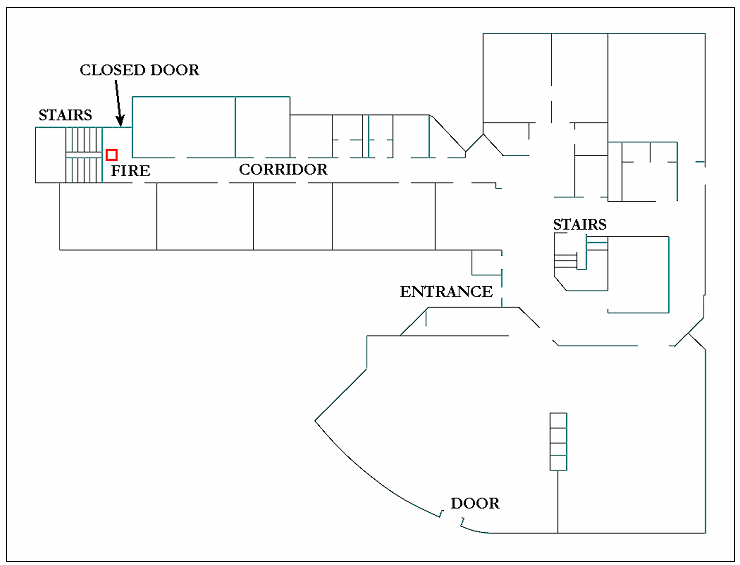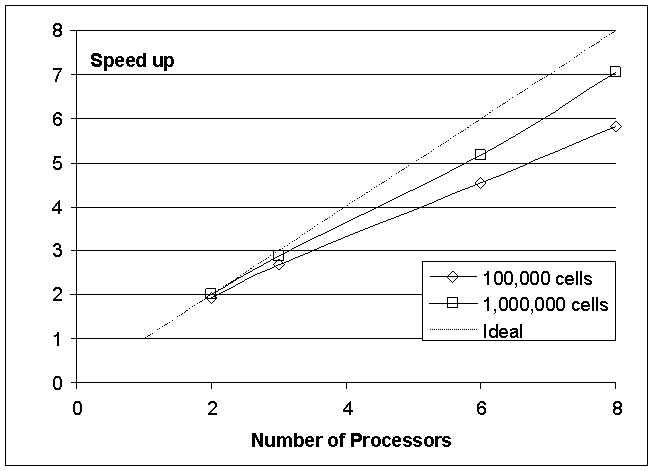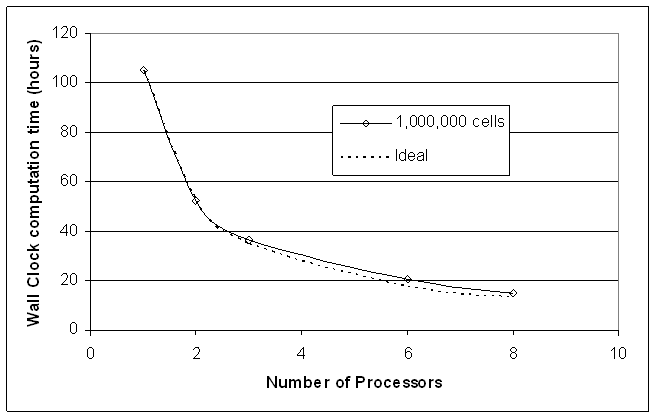| smartfire |
Home |
Capabilities |
Features |
Background |
Future |
Projects |
Publications |
Animations |
News | Press Releases | Leaflets | Team | Visitor Registration | Demo Software | Users Area | Contact |
SMARTFIRE HARDWARE REQUIREMENTS
Quick Links
SMARTFIRE Hardware Requirements
Requirements for Parallel SMARTFIRE
SMARTFIRE HARDWARE REQUIREMENTS
The SMARTFIRE software is available to run on PCs under Microsoft Windows 32 bit and 64 bit operating systems (i.e. Windows XP, Windows Vista, Windows 7 or Windows 8). It is recommended that you use Windows 7 x64 bit edition as this is the preferred development and validation platform.
SMARTFIRE
V4.3 has not been fully tested or validated under
Windows Vista or Windows 8, although our testing
indicates that the serial version of the software should
be compatible with these versions of the Windows
Operating Systems.
The minimum recommended PC hardware requirements are:
|
Requirement |
Processor |
RAM (MB) |
Graphics |
Hard Disk Space |
|
Suggested Minimum Required |
Intel Pentium 4 3.2 GHz (single core) |
1024 |
SVGA*1, *2 (800 x 600) 256 colours |
80 MB installation 20 GB for cases |
|
Minimum Recommended |
Intel Core 2 Duo E8500*3 |
4096 |
SXGA*2 (1280 x 1024) 24 Bit Colour |
80 MB installation 80 GB for cases |
|
Recommended (Q1 2013) |
Intel Core i7 Quad
Core |
24,576 (24 GB)
or more*4 |
SXGA*2 (1280 x 1024) 24 Bit Colour |
80 MB installation 500 GB for cases |
Additionally you will require a two or (preferably) three button mouse in order to operate the various user interfaces.
Please contact the SMARTFIRE developers for information about obtaining support for other hardware platforms or operating systems.
SMARTFIRE requires a suitable text editor program (correctly installed and registered to handle files of extension “.txt”) in order to edit data files (in plain text format).
[*1] Some of the Smartfire Menus might be slightly larger than SVGA display size. All of menus should still be useable at this resolution although XGA or above is preferred.
[*2]
Smartfire has been developed using "Small Fonts". There
might be menus within Smartfire that do not display
correctly when using "Large Fonts" selected from the
Display Settings panel of your operating system. It is
suggested that readability can be enhanced by changing
the DPI resolution of the screen, rather than the font
size.
[*3] Please note that currently, only Parallel Smartfire can make use of multiple cores on the newest dual/quad/multi- core CPUs.
[*4]
Only 64 bit operating systems (e.g. Windows 7 x64 bit
edition) can use more than 4 GB of memory.
REQUIREMENTS FOR PARALLEL SMARTFIRE
The only additional complexity of running Parallel SMARTFIRE is that the user is required to select the networked PC nodes that will be used to run the simulation in parallel mode. It is up to the user to ensure that the PC nodes that are to be used for parallel SMARTFIRE have:-
-
the required access permissions (administrator rights) for the user to run tasks,
-
the appropriate MPI communications and tasking software library installed on all of the PCs that are to be used (Note that not all of the PCs on the network need to have the MPI software installed – only those that will actually be used to run SMARTFIRE!),
-
a suitably fast network between the machines to make parallel processing practical (typically 100Mbit/s, and preferably 1 Gbit/s with low latencies, parallel processing is possible for 10 Mbit/s networks but only for small parallel configurations (< 4 machines)),
-
limited possibility of being switched-off, re-started or disconnected from the network for the duration of any simulations,
-
only light local processing usage that will not interfere with (or be interfered with by) the parallel SMARTFIRE task running in the background,
-
only the ‘Master’ processor (the computer that launches parallel SMARTFIRE) requires a dongle.
SMARTFIRE TYPICAL RUN-TIME PERFORMANCE Back
The speed at which SMARTFIRE can perform simulations is dependent on the nature of the simulation and the computer hardware used. The primary factors, which influence this performance, are: the size of the computational mesh, the nature of the physics options selected, the computational options selected, the computer processor type (and speed) and the amount of physical RAM available to the software.
As a benchmark measure of performance the following scenarios have been used:
Steckler
Room Fire Scenario

Figure
shows the Steckler scenario floor plan, burner location
and the front elevation.
Geometry:
Single room fire case with dimensions length=2.8m by
width=2.8m by height=2.18m, open door measuring
width=0.74m by height=1.83m centrally located on one
wall. The room is meshed with a recommended cell budget
of 26100 control volumes (cells) with directional cell
budgets of nx=45, ny=20 and nz=29. The centrally located
fire is represented as a cube of edge 0.3m which has a
steady heat release output of 59.9 kW (or an equivalent
fuel mass release rate of 0.001198 kg/s of Methane fuel
when using the gaseous combustion model).
Physics:
Transient turbulent flow with heat transfer and the
compressible ideal gas law, using two radiation options
i.e. six-flux (enhanced) radiation model and a multiple
ray radiation model with 24 rays. In certain runs the
heat release fire was replaced with a gaseous fuel
release fire. Sixty time steps of duration 1 second
(representing a total of one minute of simulated time)
were simulated with a maximum limit of 50 sweeps per
time step.
Solver
options:
Domain SOR using 200 internal iterations for
Pressure and 50 internal iterations for other scalar
variables except for Momentum and Radiation which use
only 5 internal iterations.
Run
times:
This scenario has been run - using the above
geometry, physics and solver options - on two different
PCs using either the Windows XP Pro or Windows 7
operating systems to obtain the following timings.
Table: Steckler Fire Case - Typical hardware performance (run-times).
|
Processor |
RAM |
Volumetric HRR Fire and Six Flux Radiation |
Volumetric HRR
Fire and Multi-Ray Radiation |
Combustion Fire, Toxicity and Multi-Ray Radiation (24 rays) |
|
Intel
Pentium 4 (single core), |
3 |
1h 54m
40s |
2h 30m
42s |
2h
59m 5s ( 10,745s ) |
|
Intel
Core i7 (Quad), |
24 |
49m 56s |
1h 6m 29s |
1h
12m 34s ( 4,354s ) |
|
Intel
Core i7 (Quad), |
24 |
13m 40s |
22m 26s |
27m
36s ( 1,656s ) |
Hospital Scenario
In order to give an indication of the performance on larger scenarios, an additional time study has been performed that is intended to represent more typical simulations and cell budgets that may be encountered in practical and larger-scale of fire safety engineering applications.
This hypothetical scenario involves a two storey hospital building in which the ground floor is linked to an upper floor by two open stairways. The upper floor is considered to be fully sealed (i.e. there is no external ventilation from the upper floor – except for the two stairways). There is a large fire of 1.75 MW (equivalent) peak heat output located underneath one of the sets of stairs (on the ground floor). This scenario has combustion, smoke, multi-ray (14 rays) radiation, toxicity and HCL release models enabled. The common floor plan for the scenario is as shown in the figure.

Figure shows the floor plan (common to both floors) and the fire location.
The manually refined mesh has 500,960 cells before
optimisation – but this reduces to 214,684 cells after
optimisation to remove all the cells which are not needed
(i.e. cells are removed from closed off rooms and regions
outside the building). The scenario was run for a
simulated time of ten minutes (using 300 time steps of 2
seconds per time step) and a maximum of 30 iterations per
time step. The total run times, using various serial and
parallel PC configurations, are shown in the table.
Table:
Hospital Fire Case – Typical hardware performance
(run-times).
|
Processor |
RAM (GB) |
Run-time
|
|
Intel
Core i7 (Quad), Using
single core |
24 |
21h 05m
32s ( 75,932s
) |
|
Intel
Core i7 (Quad), Parallel using 4 cores of
one PC |
24 |
8h 7m 11s ( 29,231s
) |
All timings were
taken using SMARTFIRE v4.2. It should be
noted that from SMARTFIRE v4.0 onwards,
the CFD Engine introduced significantly greater freedom
to the inner solver iterations – which produces better
convergence at the expense of runtime performance. This
is offset by the fact that from SMARTFIRE
v4.0 onwards, there have been a number of internal
optimizations which speed up the processing.
It should be noted
that if the total memory used (by all applications, the
operating system and SMARTFIRE running a
simulation case) exceeds the available physical memory,
then the operating system will be forced to start paging
to disk file and the run time performance will probably
slow to a crawl making the simulation practically
unusable. A limitation of addressing range for 32 bit
versions of Microsoft Windows means that the maximum
amount of physical memory that can be used by any
application is 2 GB. This corresponds to a typical usage
of approximately 700,000 cells in the SMARTFIRE
software. This limitation is can be overcome in two
ways:
1) The user can switch
to an x64 bit version of Microsoft Windows (Windows XP
Pro x64, Windows Vista x64, Windows 7 x64, Windows 8
x64) and the x64 bit version of SMARTFIRE.
On x64 bit systems, the memory is only limited by the
amount of physical RAM available.
2) The user can run the
scenario in a distributed way over a number of separate
32 bit PCs using the Parallel 32 bit version of SMARTFIRE.
As long as each process task of the parallel simulation
has less than the maximum number of cells, it is
possible to run much larger mesh budgets. There is still
a limitation that parallel SMARTFIRE
needs to be able to load and decompose the mesh and
spread it over the available processors.
For practical Fire
Field Modelling usage, it is recommended that all users
should deploy x64 bit versions of Windows for both
serial and parallel SMARTFIRE.
SMARTFIRE PARALLEL PERFORMANCE

Figure 1 - Parallel Speed-up for a network of Pentium III 800MHz PCs

Figure 2 - Parallel Speed-up for a network of Pentium 4 3.2GHz PCs
The speedup in run-time using Parallel SMARTFIRE depends on the size of the problem being run. As the overall problem size increases, so the communications overhead becomes less significant - when compared to the portion of the whole job being handled by each processor. Figure 1 shows the parallel speed-up for two different problem sizes (26,000 cells and 100,000 cells) on a network of Pentium III 800MHz PCs attached via a 100Mb/s LAN. Figure 2 shows the parallel speed-up for two different problem sizes (100,000 cells and 1,000,000 cells) on a network of Pentium 4 3.2GHz PCs attached via a 1Gb/s LAN. Even though the parallel speed-up will never reach the 1:1 ratio of the ideal curve, the whole job is still being processed in a fraction of the time that would be required for a serial simulation AND it is possible that a serial simulation is not possible due to the memory requirements of large cell budgets.

Figure 3 - The wall clock time required to run the 1 million cells case with a varying number of Pentium 4 PCs operating in parallel.
The 1 million cell problem was based on a test case for the nuclear industry. The domain had dimensions of 100m x 20m x 50m. The problem was run for 3 minutes of simulated time using 90 times steps of 2 seconds duration. The problem size of 1 million cells can not be accommodated on a single processor and the time taken on a single processor is estimated to be twice the time taken on two processors. This highlights a further advantage of parallel processing allowing the use of cell budgets beyond the capability of a single PC.
It can be seen, from the Figure 3, that the problem would have taken 105 hours to run on a single PC and this is reduced to less than 15 hours when 8 PCs are utilised. This allows a Fire Safety Engineer to completely run the problem overnight instead of having to wait well over 4 days to obtain the solution.

